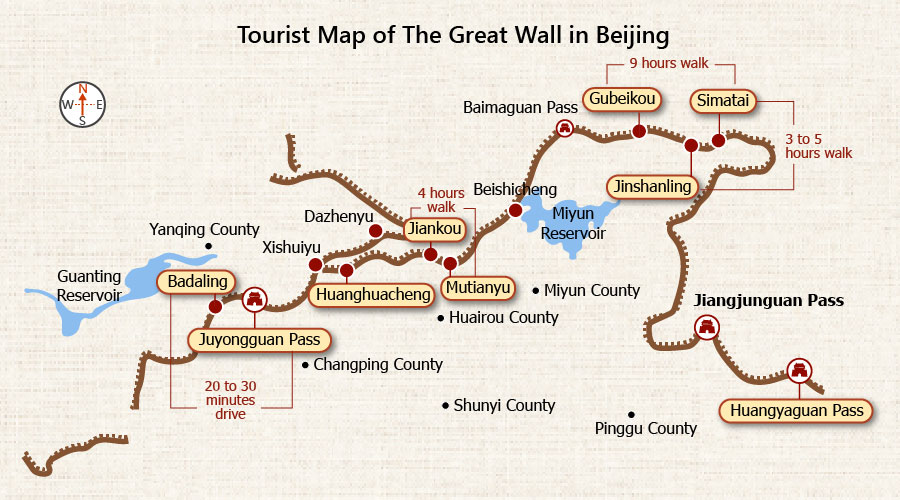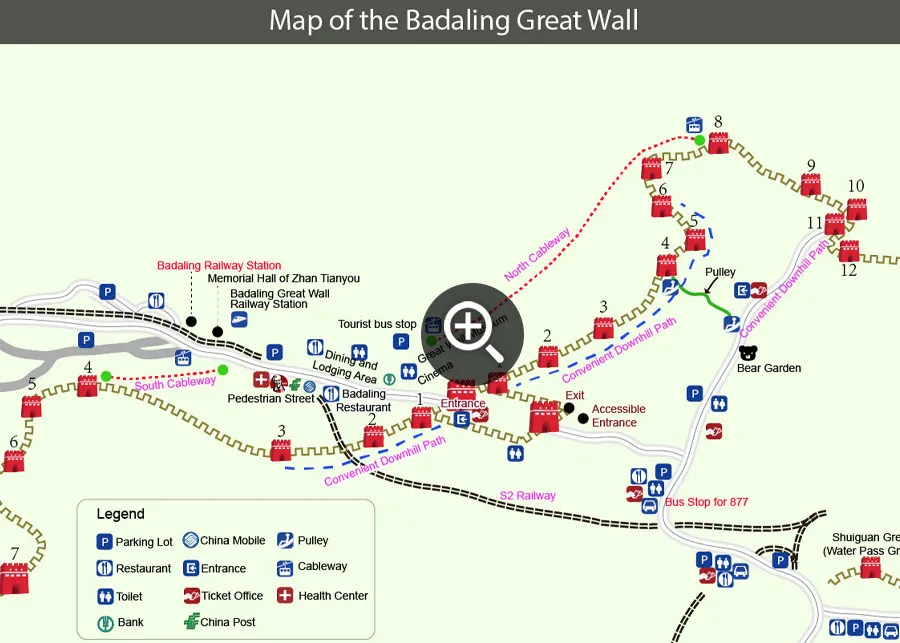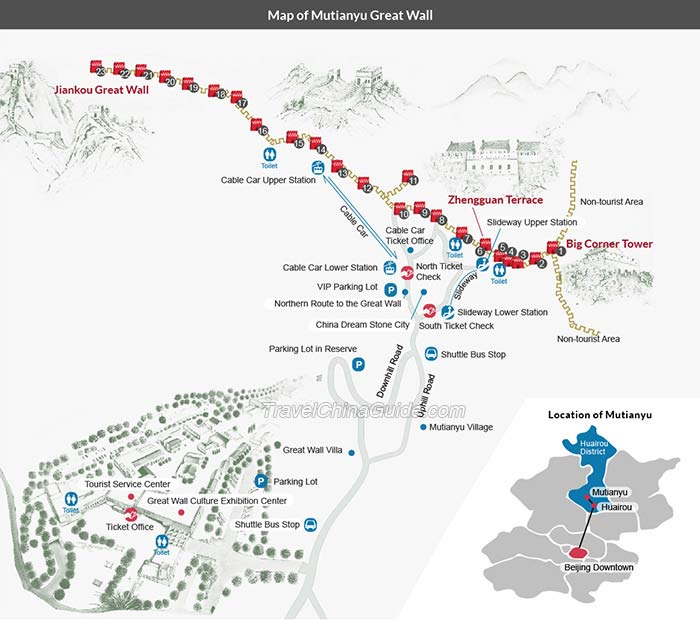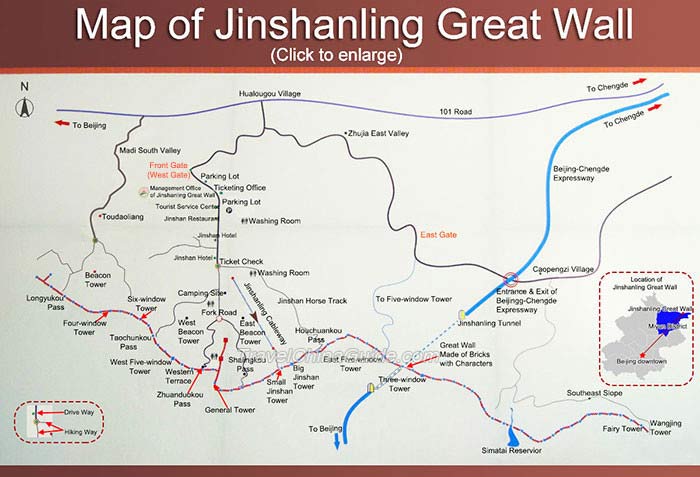The history of the Great Wall is said to start from the Spring and Autumn Periods when seven powerful states appeared at the same time. In order to defend themselves, they all built walls and stationed troops on the borders. At that time, the total length of the wall had already reached 3,107 miles, belonging to different states.
In 221 BC, the Emperor Qin absorbed the other six states and set up the first unified kingdom in Chinese history. In order to strengthen his newly born authority and defend the Huns in the north, he ordered connecting the walls once built by the other states as well as adding some sections of his own. Thus was formed the long Qin's Great Wall which started from the east of today's Liaoning Province and ended at Lintao, Gansu Province.
In the Western Han Dynasty, the Huns became more powerful. The Han court started to build more walls on a larger scale in order to consolidate the frontier. In the west, the wall along the Hexi corridor, Yumenguan Pass, and Yangguan Pass was built. In the north, Yanmenguan Pass and Niangziguan Pass in Shanxi were set up. Many more sections of the wall extended to Yinshan Mountain and half of the ancient Silk Road was along the Han's wall.
The Northern Wei, Northern Qi and Northern Zhou Dynasties all built their own sections but on a smaller scale than the walls in the Han Dynasty. The powerful Tang Dynasty saw peace between the northern tribes and central China most of the time, so few Great Wall sections were built in this period.
The Ming Dynasty is the peak of wall building in Chinese history. The Ming suffered a lot by disturbances from minority tribes such as the Dadan, Tufan and Nuzhen. The Ming court from its first emperor to the last ceaselessly built walls in the north. The main line started from Jiuliancheng near the Yalu River in the east to the Jiayuguan Pass in the west and measured over 4,600 miles. Besides adding many more miles of its own, the Ming emperors ordered enlargement of the walls of previous dynasties into double-line or multi-line walls. For example, out of Yanmenguan Pass were added three big stone walls and 23 small stone walls. Eleven Garrisons were distributed along the main line of the wall. The countless walls, fortresses, and watch towers made the country strongly fortified. In the early Qing Dynasty, some sections of the walls were repaired and several sections were extended. This great engineering work stopped in the middle of the Qing Dynasty.
Owing to its long history, natural disasters and human activities, many sections of the Great Wall are severely damaged and disappearing. Being a world-famous engineering project and witness to the rise and fall of Chinese history, the Great Wall, needs us to take immediate action to protect it!
Source: travelchinaguide.com
Selasa, 03 Januari 2012
The Maps of China's Great Walls
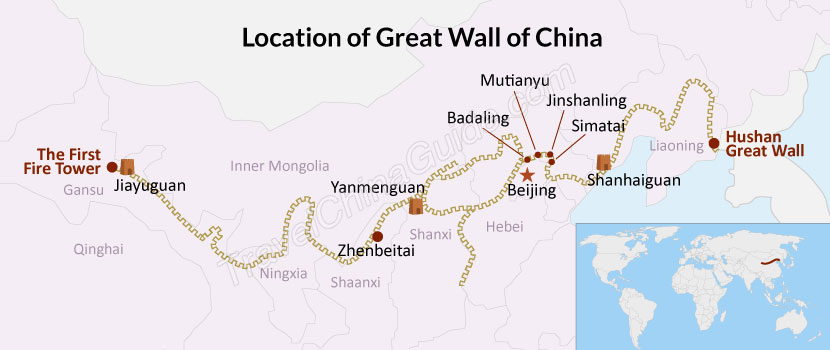
Badaling Great Wall
Location: Yanqing County, 43 miles north of Beijing
Features: the most visited and first opened section, noted for its grandness and popularity
Length: 2.3 miles
Hiking level: average (with some ups and downs and uneven surface)
Duration: 2 hours
Facilities: cable car, pulley
Nearby attraction: Ming tombs, Sacred Way, Juyongguan Pass, Water Pass, Bear Garden
Entrance fee: CNY 45 (Apr. 1 to Oct.31); CNY 40 (Nov.1 to Mar.31)
Features: the most visited and first opened section, noted for its grandness and popularity
Length: 2.3 miles
Hiking level: average (with some ups and downs and uneven surface)
Duration: 2 hours
Facilities: cable car, pulley
Nearby attraction: Ming tombs, Sacred Way, Juyongguan Pass, Water Pass, Bear Garden
Entrance fee: CNY 45 (Apr. 1 to Oct.31); CNY 40 (Nov.1 to Mar.31)
Juyongguan Pass
Location: Changping County, 37 miles from Beijing
Features: military stronghold in history, delicate brick carvings
Length: 2.6 miles
Hiking level: average (with some ups and downs and uneven surface)
Nearby attraction: Badaling, Water Pass
Entrance fee: CNY 45 (April 1 – Oct.31); CNY 40 (Nov. 1 – March 31)
Features: military stronghold in history, delicate brick carvings
Length: 2.6 miles
Hiking level: average (with some ups and downs and uneven surface)
Nearby attraction: Badaling, Water Pass
Entrance fee: CNY 45 (April 1 – Oct.31); CNY 40 (Nov. 1 – March 31)
Huanghuacheng Great Wall
Location: Jiuduhe Town, Huairou District, 40 miles from Beijing
Features: the unique Great Wall on water, beautiful yellow flowers
Length: 6.7 miles
Hiking level: average (with some ups and downs and uneven surface)
Facilities: no cable car
Entrance fee: CNY 25
Features: the unique Great Wall on water, beautiful yellow flowers
Length: 6.7 miles
Hiking level: average (with some ups and downs and uneven surface)
Facilities: no cable car
Entrance fee: CNY 25
Jiankou Great Wall
Features: dangerousness, steepness, beautiful scenery
Length: 9.3 miles from “The Ox Horn Edge Wall” to “The Nine-Eye Tower”
Hiking level: difficult, only recommended to group travelers who have enough hiking experience
Facilities: no cable car
Duration: 4 hours walk from Mutianyu to Zhengbeitai
Nearby attraction: Mutianyu
Location: Huairou County, about 45 miles from Beijing
Features: beautiful mountain scenery, compact layout, less crowded visitors
Length: 1.4 miles
Hiking level: easy (newly repaired surface with gentle inclines)
Facilities:cable car, sports slide
Duration: 2 hours
Entrance fee: CNY 40
Nearby attraction: Jiankou
Nearby attraction: Jiankou
Gubeikou Great Wall
Simatai Great Wall
Location: Gubeikou Town northeast of Miyun County, 75 miles (3 hours drive) from Beijing
Location: northeast of Miyun County, 62 miles to Beijing
Features: most parts are deserted,
which present a beauty of wildness
and historical vicissitudes
Length: 25 miles
Hiking level: average (with some
ups and downs and uneven surface)
Facilities: no cable car
Duration: 2 to 3 hours
Entrance fee: CNY 20
Features: most parts are deserted,
which present a beauty of wildness
and historical vicissitudes
Length: 25 miles
Hiking level: average (with some
ups and downs and uneven surface)
Facilities: no cable car
Duration: 2 to 3 hours
Entrance fee: CNY 20
Location: Gubeikou Town northeast of Miyun County, 75 miles (3 hours drive) from Beijing
Features: steepness, queerness and intactness
Length: 3 miles (from Wangjing Tower to Jinshanling)
Hiking level: difficult, only recommended to travelers who have enough hiking experience
Facilities: cable car
Duration: about 3 to 5 hours from Simatai to Jinshanling
Entrance fee: CNY 40
Jinshanling Great Wall
Location: Luanping County in Hebei Province, 93 miles (3 hours drive) northeast from Beijing
Features: primitiveness and majesty
Length: 6 miles from Wangjing Tower in the east to Longyukou in the west
Hiking level: difficult, only recommended to travelers who have enough hiking experience
Facilities: cable car
Duration: about 3 to 5 hours from Jinshanling to Simatai
Entrance fee: CNY 50 (Mar. 15 - Nov. 15); CNY 40 (Nov. 16- the next Mar.14)
Features: primitiveness and majesty
Length: 6 miles from Wangjing Tower in the east to Longyukou in the west
Hiking level: difficult, only recommended to travelers who have enough hiking experience
Facilities: cable car
Duration: about 3 to 5 hours from Jinshanling to Simatai
Entrance fee: CNY 50 (Mar. 15 - Nov. 15); CNY 40 (Nov. 16- the next Mar.14)
Huangyaguan Great Wall
Location: Ji County, Tianjin, 62 miles (3 hours drive) northeast of Beijing
Features: one of the ten most-visited sites in Tianjin and the miniature of China Great Wall
Length: 26 miles
Hiking level: average (a repaired wall, most parts are flat except some ups and downs)
Facilities: no cable car
Duration: 2 to 3 hours
Entrance Fee: CNY 45 (Nov.1 - Feb.28); CNY 50 (Mar.1 - Oct.31)
Features: one of the ten most-visited sites in Tianjin and the miniature of China Great Wall
Length: 26 miles
Hiking level: average (a repaired wall, most parts are flat except some ups and downs)
Facilities: no cable car
Duration: 2 to 3 hours
Entrance Fee: CNY 45 (Nov.1 - Feb.28); CNY 50 (Mar.1 - Oct.31)
source: travelchinaguide.com
China Great Walls
The Great Wall of China is a
series of stone and earthen fortifications in northern China, built
originally to protect the northern borders of the Chinese
Empire against intrusions by various nomadic groups. Several walls have
been built since the 5th century BC that are referred to collectively as the
Great Wall, which has been rebuilt and maintained from the 5th century BC
through the 16th century. One of the most famous is the wall built between
220–206 BC by the first Emperor of China, Qin Shi Huang. Little of that wall remains; the
majority of the existing wall was built during the Ming Dynasty.
 Gansu Great Wall:
Gansu Great Wall:
In Gansu, numerous cultural relics of the Silk Road can be found, such as the Mogao Caves and Maijishan Grottoes. Also it played a very important role in the ancient military defense. A lot of Great Wall relics have been found in this region. The most famous one is Jiayuguan Pass in Jiayuguan City, which is the western beginning of the Ming Great Wall. Additionally, the Overhanging Great Wall is worth a visit.
 Hebei Great Wall:
Hebei Great Wall:
There are a large number of Great Wall relics in Hebei Province. Most of them were built in the Ming Dynasty. In the east of Hebei stand the Great Wall of Laolongtou, Shanhaiguan Pass, Xifengkou&Sandaoguan, Zijingguan, Jiaoshan, Qingshankou, Malanguan, etc. In northwestern Hebei, you can see Zhangjiakou, Changyukou and Qingbiankou Great Wall. And in the southwest of Hebei, Wulonggou, Futuyu, and Chajianling can be seen.
 Inner Mongolia Great Wall:
Inner Mongolia Great Wall:
Inner Mongolia boasts the largest number of Great Wall relics. Its total length covers one third of the whole length of China Great Wall. However, a great many remains were destroyed and even some of them have died out. For instance, in the area of Juyanhai Lake, ten fire towers have disappeared.
 Liaoning Great Wall:
Liaoning Great Wall:
It's thought that the eastern beginning of the Great Wall is the Shanhaiguan Pass in Hebei. However, in recent years, people find that its beginning is in Liaoning Province. Most of the Great Wall in Liaoning was built in the Ming Dynasty (1368-1644). In that period, the Great Wall was divided into nine districts, called Nine Important Towns on the Border. Liaoning Great Wall was administered by Liaodong Town. Now, it's uncommon to see its relics. The remains mainly distribute in the northwest of this region.
 Hushan
Hushan  Jiumenkou
Jiumenkou
 Ningxia Great Wall:
Ningxia Great Wall:
In Ningxia, the Sanguankou (Three Passes) Great Wall is highly recommended. In the Ming Dynasty, the Tartar and Wala tribes of Mongolia often came into the northwest China from Sanguankou. For the sake of safety, Sanguankou Great Wall was built.
 Shaanxi Great Wall:
Shaanxi Great Wall:
In Shaanxi, the Great Wall mainly distributes in Shenmu, Fugu, Jingbian and Hengshan in Yulin, Wuqi and Fuxian in Yanan and Dali, Heyang, Pucheng, Chengcheng, Baishui and Haicheng in Weinan. In length of more than 2,000 kilometers, Shaanxi Great Wall was built ranging from the Warring States Period to the Ming Dynasty.
 Shanxi Great Wall:
Shanxi Great Wall:
In history, Shanxi was a point of battle. Thus, a lot of Great Wall remains can be found there. The Great Wall there comprises inner and outer Great Wall. The inner Great Wall is the second line of defence. In Shanxi, many famous passes can be found, such as
 Tianjin Great Wall:
Tianjin Great Wall:
The Great Wall in Tianjin was mostly built in the Ming Dynasty. And most of them were stone-structured. Only the Huangyaguan Great Wall was made up of bricks. Tianjin Great Wall has a complete defensive system, including walls, terraces, passes, fire towers, fire pools, ovens and fortresses.
 Huangyaguan
Huangyaguan  Taipingzhai
Taipingzhai
The Great Wall stretches
from Shanhaiguan in the east, to Lop Lake in the west,
along an arc that roughly delineates the southern edge of Inner Mongolia.
The Great Wall of China, one of the greatest wonders of the
world, was listed as a World Heritage by UNESCO in 1987. Just like a
gigantic dragon, the Great Wall winds up and down across deserts, grasslands,
mountains and plateaus, stretching approximately 8,851.8 kilometers (5,500.3
miles) from east to west of China. This is made
up of 6,259.6 km (3,889.5 mi) sections of actual wall, 359.7 km
(223.5 mi) of trenches and 2,232.5 km (1,387.2 mi) of natural
defensive barriers such as hills and rivers. With
a history of more than 2000 years, some of the sections are now in ruins or
have disappeared. However, it is still one of the most appealing attractions
all around the world owing to its architectural grandeur and historical
significance.
Great Wall Facts
Chinese Name: 长城/万里长城
Chinese Pinyin: Cháng Chéng/Wàn Lǐ Cháng Chéng
English Translation: Great Wall/Great Wall of 10,000 Li
Length: 8,851.8 km (5,500 miles)
Builder: the ancient Chinese laboring people (common people, farmers, soldiers and slaves)
Construction Period: About 2,000 years from the Warring States Period (476 BC - 221 BC) to Ming Dynasty (1368-1644)
Chinese Pinyin: Cháng Chéng/Wàn Lǐ Cháng Chéng
English Translation: Great Wall/Great Wall of 10,000 Li
Length: 8,851.8 km (5,500 miles)
Builder: the ancient Chinese laboring people (common people, farmers, soldiers and slaves)
Construction Period: About 2,000 years from the Warring States Period (476 BC - 221 BC) to Ming Dynasty (1368-1644)
Enjoying the fame of "Wan Li Chang Cheng", China Great Wall starts from Hushan in Liaoning in the east and ends at Jiayuguan Pass in Gansu in the west, via the nine provinces or cities in northern China, including Liaoning, Hebei, Beijing, Tianjin, Shanxi, Shaanxi, Inner Mongolia, Ningxia and Gansu. It is often compared to a huge dragon winding up and down in the mountains, grassland and deserts. In Chinese history, over 20 states and dynasties have built the Great Wall, and the sections built in Qin (221 BC-206 BC), Han (206BC-220) and Ming (1368-1644) dynasties exceed 10,000 Li (about 3,107 miles). The new survey of the length of the Great Wall in Ming Dynasty has confirmed that it is 8,851.8 km (5,500 miles) long.
At present, the China Great Wall has already lost its military function, and many sections have been repaired and opened to the public. Among them, Badaling is the most famous and greatest which receives the most visitors from home and abroad. Mutianyu is famous for its spectacular scenery, Jinshanling and Simatai are well known for the wildness and cragginess, and Jiankou is attracted by its dangerous location. Due to these varieties, it's no wonder that Great Wall is the most welcomed scenic sight in China.
Great Wall Tops  The wall receives most visitors: Badaling Great Wall
The wall receives most visitors: Badaling Great Wall
 The most eastern wall (Ming Dynasty): Hushan Great Wall
The most eastern wall (Ming Dynasty): Hushan Great Wall
 The most western wall (Ming Dynasty): Jiayuguan Pass
The most western wall (Ming Dynasty): Jiayuguan Pass
 The most western wall (Han Dynasty): Yumenguan Pass
The most western wall (Han Dynasty): Yumenguan Pass
 The most dangerous wall (Ming Dynasty): Jiankou Great Wall
The most dangerous wall (Ming Dynasty): Jiankou Great Wall
 The earliest wall: wall built in Chu State in Warring States Period (476 BC - 221 BC)
The earliest wall: wall built in Chu State in Warring States Period (476 BC - 221 BC)
 The wall with most construction styles: Great Wall in Zhangjiakou City
The wall with most construction styles: Great Wall in Zhangjiakou City
 The highest wall: the wall built in 2,000m (6,562 feet) tall Huapiling and bingshanliang mountains in Zhangjiakou City
The highest wall: the wall built in 2,000m (6,562 feet) tall Huapiling and bingshanliang mountains in Zhangjiakou City
 The wall with most fortresses & the wall where the most frequent wars took place: Great Wall in Zhangjiakou City
The wall with most fortresses & the wall where the most frequent wars took place: Great Wall in Zhangjiakou City
The No.1 city terrace: Zhenbeitai in Shaanxi
The No.1 fortress: Jiayuguan Pass in Gansu
The No.1 tower: Nine-Eye Tower in Beijing
The No.1 city gate: Dajing Gate in Zhangjiakou
The first pass under heaven: Shanhaiguan Pass in Hebei
The three inner side passes: Juyongguan Pass, Zijingguan Pass, Daomaguan Pass
The three outer side passes: Yanmenguan Pass,Ningwuguan Pass, Pianguan Pass
The eight big passes: Shanhaiguan Pass, Juyongguan Pass, Zijingguan Pass, Yanmenguan Pass, Niangziguan Pass, Pianguan Pass, Jiayuguan Pass, Yumenguan Pass
The first Chinese finished Great Wall hiking: Liu Yutian in 1984The first foreigner to explore the whole length of the Great Wall: William Edgar Geil in 1908
The No.1 fortress: Jiayuguan Pass in Gansu
The No.1 tower: Nine-Eye Tower in Beijing
The No.1 city gate: Dajing Gate in Zhangjiakou
The first pass under heaven: Shanhaiguan Pass in Hebei
The three inner side passes: Juyongguan Pass, Zijingguan Pass, Daomaguan Pass
The three outer side passes: Yanmenguan Pass,Ningwuguan Pass, Pianguan Pass
The eight big passes: Shanhaiguan Pass, Juyongguan Pass, Zijingguan Pass, Yanmenguan Pass, Niangziguan Pass, Pianguan Pass, Jiayuguan Pass, Yumenguan Pass
The first Chinese finished Great Wall hiking: Liu Yutian in 1984The first foreigner to explore the whole length of the Great Wall: William Edgar Geil in 1908
Famous Sections of Great Wall
 Beijing Great Wall:
Beijing Great Wall:
In Beijing, there are many relics of the Great Wall, most of which were built around 1540. The notable sections include:
In Beijing, there are many relics of the Great Wall, most of which were built around 1540. The notable sections include:
In Gansu, numerous cultural relics of the Silk Road can be found, such as the Mogao Caves and Maijishan Grottoes. Also it played a very important role in the ancient military defense. A lot of Great Wall relics have been found in this region. The most famous one is Jiayuguan Pass in Jiayuguan City, which is the western beginning of the Ming Great Wall. Additionally, the Overhanging Great Wall is worth a visit.
There are a large number of Great Wall relics in Hebei Province. Most of them were built in the Ming Dynasty. In the east of Hebei stand the Great Wall of Laolongtou, Shanhaiguan Pass, Xifengkou&Sandaoguan, Zijingguan, Jiaoshan, Qingshankou, Malanguan, etc. In northwestern Hebei, you can see Zhangjiakou, Changyukou and Qingbiankou Great Wall. And in the southwest of Hebei, Wulonggou, Futuyu, and Chajianling can be seen.
Inner Mongolia boasts the largest number of Great Wall relics. Its total length covers one third of the whole length of China Great Wall. However, a great many remains were destroyed and even some of them have died out. For instance, in the area of Juyanhai Lake, ten fire towers have disappeared.
It's thought that the eastern beginning of the Great Wall is the Shanhaiguan Pass in Hebei. However, in recent years, people find that its beginning is in Liaoning Province. Most of the Great Wall in Liaoning was built in the Ming Dynasty (1368-1644). In that period, the Great Wall was divided into nine districts, called Nine Important Towns on the Border. Liaoning Great Wall was administered by Liaodong Town. Now, it's uncommon to see its relics. The remains mainly distribute in the northwest of this region.
In Ningxia, the Sanguankou (Three Passes) Great Wall is highly recommended. In the Ming Dynasty, the Tartar and Wala tribes of Mongolia often came into the northwest China from Sanguankou. For the sake of safety, Sanguankou Great Wall was built.
In Shaanxi, the Great Wall mainly distributes in Shenmu, Fugu, Jingbian and Hengshan in Yulin, Wuqi and Fuxian in Yanan and Dali, Heyang, Pucheng, Chengcheng, Baishui and Haicheng in Weinan. In length of more than 2,000 kilometers, Shaanxi Great Wall was built ranging from the Warring States Period to the Ming Dynasty.
In history, Shanxi was a point of battle. Thus, a lot of Great Wall remains can be found there. The Great Wall there comprises inner and outer Great Wall. The inner Great Wall is the second line of defence. In Shanxi, many famous passes can be found, such as
The Great Wall in Tianjin was mostly built in the Ming Dynasty. And most of them were stone-structured. Only the Huangyaguan Great Wall was made up of bricks. Tianjin Great Wall has a complete defensive system, including walls, terraces, passes, fire towers, fire pools, ovens and fortresses.
source from: travelchinaguide.com / wikipedia.org
Langganan:
Postingan (Atom)
